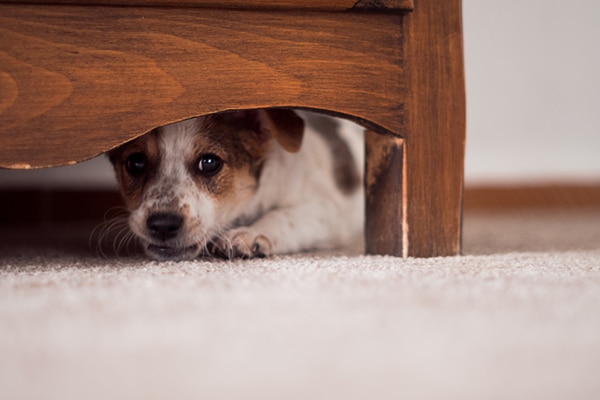counter-conditioning and desensitization, Dog Aggression, dog anxiety, dog fears, dog phobias
Counter-conditioning and desensitization: Exposure therapy for dogs
Counter-conditioning and desensitization: Exposure therapy for dogs
By Will Bangura, M.S., CBCC-KA, CPDT-KA, (Dog Behaviorist), Certified Dog Behavior Consultant
Counter-conditioning and desensitization for dogs are two commonly used techniques for helping dogs overcome fears and phobias. These techniques involve changing a dog’s emotional response to a specific stimulus by associating it with something positive.
Counter-conditioning is the process of changing a dog’s emotional response to a specific stimulus by pairing it with something the dog enjoys or finds rewarding. For example, if a dog is afraid of strangers, counter-conditioning might involve pairing the presence of strangers with treats or other rewards. Over time, the dog’s emotional response to strangers changes from fear to excitement or anticipation of a reward.
Desensitization is the process of gradually exposing a dog to a specific stimulus at low levels and gradually increasing the intensity or proximity of the stimulus over time. This helps the dog become accustomed to the stimulus and eventually not react to it.
Counter-conditioning and desensitizing a dog with a fear of people:
Here are some specific step-by-step instructions for counter-conditioning and desensitizing a dog with a fear of strangers:
- Start by finding a low-stress situation where strangers are present, such as a park on a weekday morning when few people are around.
- Begin by introducing the dog to strangers at a distance where the dog is still comfortable, such as 20 feet away.
- As the dog becomes more comfortable with the presence of strangers, gradually decrease the distance between the dog and the strangers.
- Reward the dog with treats or other rewards for calm behavior around strangers.
- Repeat this process over several weeks or months, gradually increasing the number and proximity of strangers until the dog is comfortable around strangers in various situations.
Counter-conditioning and desensitizing a dog with sound phobias:
Here are some specific step-by-step instructions for counter-conditioning and desensitizing a dog with a phobia of thunderstorms:
- Start by playing recordings of thunderstorm sounds at a very low volume while the dog is engaged in an activity it enjoys, such as playing with a toy or eating a treat.
- Gradually increase the volume of the thunderstorm sounds over several weeks or months.
- Reward the dog with treats or other rewards for calm behavior during the thunderstorm sounds.
- Repeat this process until the dog can remain calm during thunderstorm sounds played at a normal volume.
- Gradually introduce the dog to real thunderstorms in a controlled environment, such as a fenced-in yard, with a person close by to provide comfort and rewards for calm behavior.
Counter-conditioning and desensitizing a dog with aggression towards dogs:
Here are some specific step-by-step instructions for counter-conditioning and desensitizing a dog with aggression toward other dogs:
- Start by introducing the dog to other dogs at a distance where the dog is still comfortable, such as 50 feet away.
- As the dog becomes more comfortable with the presence of other dogs, gradually decrease the distance between the dog and the other dogs.
- Reward the dog with treats or other rewards for calm behavior around other dogs.
- Repeat this process over several weeks or months, gradually increasing the number and proximity of other dogs until the dog is comfortable around other dogs in various situations.
- Close supervision and management are essential in case of any accidents.
“The World’s Most Effective Calming Aid for Dog Anxiety or It’s FREE!”
Click Above
It is important to note that counter-conditioning and desensitization should always be done under the guidance of a qualified professional, such as a veterinarian, animal behaviorist, or certified dog trainer. These techniques should not be attempted without proper guidance and support, as they can be dangerous if done incorrectly.
For more detailed information check out our comprehensive guide on counterconditioning and desensitization training for dogs
References:
Counter-Conditioning and Desensitization: How to Help Dogs with Anxiety, Fears, Phobias, Aggression or Reactivity. (1 Hour 2 Minutes) Podcast
Books:
- “Treat Your Dog: Understanding and Changing Behavior” by R.K. Anderson
- “The Culture Clash” by Jean Donaldson”
- Behavior Adjustment Training: BAT for Fear, Frustration, and Aggression in Dogs” by Grisha Stewart
Websites:
- American College of Veterinary Behaviorists (ACVB): https://drsophiayin.com/blog/entry/counter-conditioning-and-desensitization-in-dog-behavior-modification/
- The Humane Society of the United States (HSUS): https://www.humanesociety.org/resources/counter-conditioning-and-desensitization
- The Association of Professional Dog Trainers (APDT): https://apdt.com/resources/counter-conditioning-desensitization/
Note: It is essential to work with a professional dog trainer, certified dog behavior consultant, dog behaviorist, or veterinary behaviorist when using counter-conditioning and desensitization for behavioral issues such as fears, phobias, or aggression. These techniques require a gradual approach and should be tailored to each dog’s needs.


